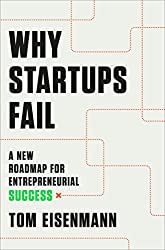
Rating: 8.4/10.
Why Startups Fail: A New Roadmap for Entrepreneurial Success by Tom Eisenmann
It is well known that most startups fail. This book examines common failure patterns for startups through case studies: beginning with the problems faced by early-stage startups, then another different set of problems faced by startups as they grow. The case studies focus on venture-backed B2C startups that raised at least a seed round before eventually failing. One difficulty in analyzing failures is that usually multiple reasons contribute to a startup’s demise: the founders made some mistakes, the product failed to find market fit, the company failed to raise investment, etc, and it’s hard to say which reason was the root cause for failure. Another difficulty is defining whether a startup is a failure or not – in this book, failure is defined by returning less money to investors than was put in.
A startup faces many “Catch-22” tradeoffs in product, engineering, founder fit, hiring, marketing, etc, such that an incorrect decision in either direction could be fatal. For example, it is often the case that growing too fast is a mistake, but in other cases, the mistake is growing too slowly. The author conducts a survey of both successful and unsuccessful startup founders to determine which types of mistakes are the most common.
The first case study is Quincy, a startup that manufactured apparel for women. The startup saw promising results during pilot trial of the product, but ran into a lot of operational problems designing, manufacturing, and shipping clothing since the founders had no expertise in the clothing industry. The founders had planned to learn on the job, but this proved to be inadequate because each mistake was expensive in terms of both time and money. Hiring industry specialists was also problematic because they specialized on one aspect of the process and were not used to a startup environment. The idea was not necessarily bad, but the founders lacked the skills to properly execute. Since the project was so capital heavy, it would’ve probably been better if they pursued a narrower goal in the beginning to conserve capital while they learned.
Next, Triangulate was a startup in the dating app market: they iterated through several concepts for dating apps, including algorithmic matching and getting a friend to join as a “wingman”, but ultimately, they never achieved a product that had generated enough market demand and ran out of money. These features turned out to be not useful because users simply wanted a way to quickly browse profiles of potential partners. Their mistake was not validating user needs early enough, wasting a lot of engineering time to build fully-fledged features that ended up not being useful. This is a very common failure pattern for early startups, and the author discusses many ways you can validate your idea without building a fully functional product.
Baroo was a startup for dog owners living in apartments to find people to walk their dogs. After a very successful initial launch, Baroo quickly expanded to many apartments in several different cities. However, what the founders did not realize at the time was that the pilot launch customers had certain characteristics that did not reflect the general population – for example, the pilot users happened to live in a new apartment, whereas existing apartment dwellers faced switching costs when switching to a new dog walker. Thus, the early success made the founders believe they had achieved product-market fit, when in fact they had not, and the startup began rapidly losing money once it expanded. To avoid such “false positives”, founders need to realize when there are differences between early adopters and mainstream customers.
The second part of the book is about growth-stage startups. Once startups get past the initial stage and achieve product-market fit on a small scale, they face different challenges as they expand. Increased scale of operations means that the company needs to hire teams of specialists, and introduce more complex hierarchies and processes to manage larger teams effectively. If this is done poorly, product quality suffers, harming the company’s reputation. The cost of user acquisition increases as the pool of early adopters is exhausted and mainstream customers may be less profitable. Growing startups need to raise more funding, which leads to challenges with managing the needs of both earlier and later investors.
The case studies examined two e-commerce companies that scaled too quickly. Once they expanded their operations to other markets, they found that the business model became unprofitable. After saturating their marketing channels, acquiring users became more expensive, a phenomenon known as the “LTV/CAC squeeze”; additionally, the size of the company meant that operational issues could not be addressed quickly. Likely, these companies would’ve done better had they not tried to grow so quickly. The final case study was on a “moonshot” company: Better Place, an Israeli startup that tried to create a network of charging stations for electric vehicles. Moonshot companies have an even higher rate than other startups because they require a lot of things to simultaneously work right, including technology that is yet unproven. They fail when the product turns out to be more expensive and works less well than expected, leading to low sales and difficulty raising additional funds.
The third part of the book describes the process of startup failure. Typically, failure is a slow process – as the company depletes its runway, founders pursue options like pivoting, raising more money, selling the company, and laying off employees. At some point, when all other options are exhausted, it becomes clear that failure is available, triggering the legal accounting procedures to shut down the company cleanly, including paying back outstanding debts and returning leftover money to investors. When their startup fails, founders are mentally exhausted, yet relieved their problems are over. They should take some time to recuperate before reflecting on their mistakes and taking away lessons that they learned; most founders are able to quickly find another great opportunity.
This is a great book for entrepreneurs, containing real-life case studies and valuable advice on the patterns of how startups fail. Although most startups fail, the stories of the few successful ones attract most of our attention, and it is hard to find information about unsuccessful ones. Studying failures is worthwhile because if you can avoid some common ways to fail, your chances of success will increase.



